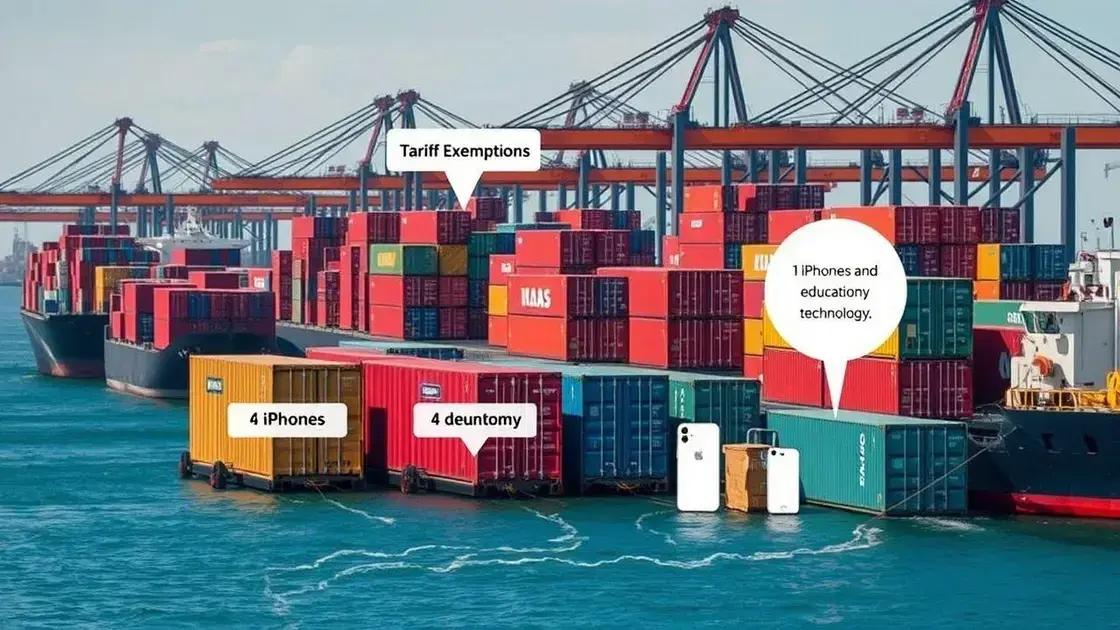Teacher workforce challenges: tariff exemptions for iPhones

Anúncios
The teacher workforce faces significant challenges such as high workloads, burnout, and the need for technology integration, while the future emphasizes adaptability, support, and diversity to enhance educational effectiveness.
Teacher workforce challenges are more pressing than ever, especially with recent policy changes impacting technology access. How does this affect education? Let’s explore the implications.
Anúncios
Understanding the teacher workforce landscape
Understanding the teacher workforce landscape is crucial in today’s educational environment. With changes in policies and technology, it is important to analyze how these factors influence teaching and learning.
The Current State of the Teacher Workforce
Across the globe, the teacher workforce faces numerous challenges that affect their effectiveness and the educational system as a whole. Issues such as teacher shortages, burnout, and the need for professional development contribute to a difficult landscape.
Anúncios
Key Challenges Faced by Educators
- High turnover rates leading to instability in classrooms.
- Inadequate support and resources for teachers.
- Pressure from standardized testing and curriculum mandates.
- Need for ongoing training to keep up with technology.
Many teachers report feeling overwhelmed as they try to balance their responsibilities. This can lead to job dissatisfaction and ultimately leaving the profession. Understanding these issues is crucial for improving the overall effectiveness of teaching.
Furthermore, the integration of technology in classrooms presents both opportunities and challenges. While tools like iPhones can enhance learning, they also require teachers to adapt their methods continually. This ongoing adjustment can add to the stress but also provides avenues for creativity in lesson planning.
Looking Ahead
Addressing the teacher workforce challenges requires collaboration among policymakers, school administrators, and educators. By investing in support systems and providing necessary resources, the landscape can significantly improve. The future of education depends on a stable and supported teacher workforce.
Impact of technology on education
The impact of technology on education is profound and multifaceted. As classrooms become more digital, traditional teaching methods are evolving rapidly. Technology enhances learning experiences, making education more interactive and accessible.
Benefits of Educational Technology
Integrating technology in the classroom offers several advantages. Students can access a wealth of information at their fingertips. This shift allows for personalized learning, where each student can progress at their own pace.
- Enhanced Engagement: Technology can make lessons more interesting, capturing students’ attention.
- Immediate Feedback: Online assessments provide instant results, allowing teachers to adjust their teaching swiftly.
- Collaboration Tools: Platforms like Google Classroom enable teamwork and communication among students.
- Access to Resources: Students can tap into online libraries and educational websites.
However, with these benefits also come challenges. Not all students have equal access to technology, leading to disparities in learning opportunities. Additionally, teachers must adapt to new tools, which can be overwhelming without proper training.
Challenges of Implementing Technology
Implementing technology in education isn’t just about having the latest gadgets. It involves thoughtful integration into the curriculum. Teachers face a learning curve as they become familiar with new tools. Moreover, schools need infrastructure, such as reliable internet, to support digital learning.
Despite these hurdles, the move towards digital education is essential. The pandemic has accelerated this trend, showing how crucial technology can be for ensuring continuous learning. As we look ahead, embracing digital tools is necessary for preparing students for a rapidly changing world.
Tariff exemptions and their implications

The discussion around tariff exemptions and their implications is vital for understanding the broader economic landscape. Recent changes in tariff policies can significantly affect manufacturers, consumers, and the overall market.
Understanding Tariff Exemptions
Tariff exemptions allow certain products to enter a country without the usual taxes imposed on imports. For instance, the recent exemption for Chinese-made iPhones is noteworthy. These exemptions can lead to lower prices for consumers while benefiting specific sectors of the economy.
- Cost Savings: Consumers may see reduced prices on products due to lower import costs.
- Encouragement of Trade Relations: Exemptions can foster better relations between countries.
- Market Competition: Tariffs can impact local producers by altering competitive dynamics.
- Impact on Technology Accessibility: With lower prices, more individuals can access technology.
While exemptions sound beneficial, they raise questions about domestic industries. Companies that compete with exempted products may struggle, leading to job losses and economic shifts in certain sectors. Additionally, reliance on imported goods can make economies vulnerable to international market changes.
Implications for Education and Technology
In the educational sector, tariff exemptions for technology products mean that schools can afford new resources such as laptops and tablets. This accessibility can have a lasting impact on the quality of education. However, it is crucial to consider how this impacts local tech companies that provide similar products.
Moreover, as technology becomes more accessible, it sets the stage for equitable learning opportunities across diverse populations. Schools in lower-income areas can now acquire the tools necessary for modern education, narrowing the digital divide. This shift can ultimately influence the teacher workforce, as educators adapt to utilizing these new technologies in their classrooms.
Challenges faced by educators today
The challenges faced by educators today are numerous and complex. Teachers are navigating a rapidly changing educational landscape filled with obstacles that impact their roles and effectiveness.
High Workload and Burnout
One significant issue is the heavy workload that teachers carry. With lesson planning, grading, and administrative tasks, many educators find it hard to maintain a work-life balance. This overwhelming workload often leads to burnout, affecting their enthusiasm and productivity in the classroom.
- Increased paperwork and bureaucratic demands.
- Lack of time for personal and professional development.
- Emotional fatigue from managing diverse classroom needs.
- Pressure to meet standardized testing goals.
These demands can make teaching feel less rewarding and more like a chore, leading to higher turnover rates among educators.
Adapting to Technology
Technology is another significant challenge. While it offers numerous benefits, incorporating new tools into the classroom often requires extensive training and support. Educators must learn to use software and hardware effectively, which can be daunting. Additionally, not all students have equal access to technology, leading to disparities in learning opportunities.
Teachers need to create inclusive environments where all students can thrive. This often means finding ways to bridge the digital divide and ensure that technology enhances learning rather than hinders it.
Furthermore, educators are tasked with teaching digital literacy alongside traditional subjects. This adds another layer of complexity to their roles, demanding continual adaptation to keep up with changing technology.
Support and Resources
Many educators report feeling under-supported and lacking necessary resources. Schools may face budget cuts that limit access to essential materials or professional development, which can leave teachers feeling isolated. They often seek collaboration and support from their peers, but limited time and resources can make this difficult.
It’s vital for schools and districts to recognize these challenges and work towards providing the support that educators need. When teachers are supported, they are more likely to stay in the profession and positively impact their students’ lives.
Future outlook for the teacher workforce
The future outlook for the teacher workforce is becoming an increasingly critical topic in education discussions. As society evolves, so does the landscape of teaching and the roles educators play.
Emerging Trends in Education
One noticeable trend is the growing integration of technology in classrooms. As education technology continues to advance, teachers will need to adapt to new tools and platforms. This transformation can create exciting possibilities for interactive learning but also raises concerns about training and preparedness.
- Increased use of online learning resources.
- Growth of blended learning environments.
- Need for professional development in technology.
- Focus on STEM education and specialty areas.
Moreover, the demand for teachers specializing in STEM subjects is skyrocketing. With a focus on preparing students for a technology-driven job market, educators will play a crucial role in cultivating the next generation of innovators.
Addressing Workforce Challenges
As the teacher workforce faces various challenges, such as burnout and retention, schools and policymakers must respond effectively. Strategies for improving educator satisfaction are essential for maintaining a robust teaching force.
Initiatives that enhance support for teachers can lead to a more sustainable future. For instance, mentoring programs and reduced workloads play an important role in retaining experienced educators. Investing in mental health resources can also promote well-being and job satisfaction among teachers.
Additionally, schools should encourage diverse hiring practices to bring in talented teachers from various backgrounds. A diverse workforce can enrich the educational experience and provide different perspectives for students.
Preparing for the Future
In conclusion, the teacher workforce must evolve alongside societal changes. Schools need to prepare for a future that emphasizes adaptability and continuous learning. By recognizing and addressing existing challenges, we can build a strong foundation for a sustainable and effective teacher workforce.
FAQ – Questions About the Teacher Workforce
What challenges do educators face today?
Educators are dealing with high workloads, burnout, and the need to integrate new technology into their teaching.
How is technology impacting the teacher workforce?
Technology offers tools that enhance learning but requires teachers to adapt and continuously learn new skills.
Why is support important for teachers?
Support systems help reduce burnout and improve job satisfaction, allowing teachers to succeed in their roles.
What is the future outlook for the teacher workforce?
The future focuses on adaptability, diversity, and ongoing professional development to ensure a robust teaching community.






